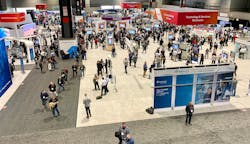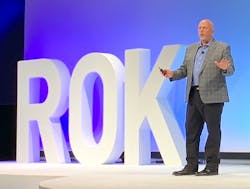The 31st annual Rockwell Automation Fair drew more than 18,000 attendees over two days in Chicago. The event was preceded by Rockwell’s two-day Process Solutions User Group (PSUG), a smaller gathering of 750 people focused on how Rockwell leverages input from its users in the processing industries to evolve the company’s technology products.
Two major updates involving Rockwell Automation’s PlantPAx and FactoryTalk software were announced at the event.
“PlantPAx 5.2 has a new I/O platform called Flexha 5000; and this I/O platform offers full redundancy from the wire all the way to the controller,” said Jim Winter, director, global process business at Rockwell Automation. With Flexha 5000, “we don’t have to have dedicated cards— one card works with all the signals.”
He added that this capability dramatically reduces engineering time to design systems, as well as reducing startup time, and making PlantPAx more flexible for expansions.
Features of the Flexha 5000 include the ability to:
- Mount up to 24 I/O modules on a single node, vertically or horizontally, and in any module sequence;
- Operate at -40° to +70°C and in extreme environments and in hazardous areas under Class I, Division 2, Zone 2, and Groups A, B, C, D;
- Reduce downtime via access to additional process diagnostics via HART Premier Integration in Studio 5000 Logix Designer software;
- Configure I/Os per channel within Studio 5000 software as analog (HART capable) or discrete, input or output; and
- Operate in simplex or duplex module configurations.
Brian Shepherd, senior vice president of software and control at Rockwell Automation, introduced the company’s new FactoryTalk Edge platform— a new software-as-service (SaaS) that “lives in the cloud and allows customers to orchestrate and manage edge devices across a fleet of factories…anywhere in the world,” he said. “This is bringing an IT mindset about managing a fleet of devices across the company to the OT world where you’re doing that remotely, via the cloud, and you’re doing it securely.”
Security in the FactoryTalk Edge platform provides protection against cyberattacks with signed configuration and images, hardware root of trust, and measured boot and remote attestation.
Shepherd added that customer feedback prompted Rockwell Automation to develop FactoryTalk Edge with a focus on speed and maneuverability via the cloud. “We’re hearing from all our customers that they still don’t feel like they’re moving fast enough. Those old highway signs used to say ‘speed kills’. But it seems today that speed is the only way to survive. We’ve also heard about the importance of agility, because speed in one direction is not enough. The targets keep moving, the landscapes are shifting, the threats are accelerating, and you need to be able to pivot. The cloud is tried and tested. It’s proven, and it’s relied upon.”
The Future of Automation
Rockwell Automation detailed its strategy for the future of automation through a session hosted by Matheus Bulho, vice president and general manager of production automation, and Dan DeYoung, director of production automation. They explained the three key pillars Rockwell Automation views as being critical to advancing automation: simplify production elements, remove boundaries and accelerate outcomes, and mitigate risk.
During their presentation, DeYoung mentioned these three pillars were developed in response to what’s happening in the marketplace today, noting that 88% of executives think their customers are changing faster than their businesses and automation systems can keep up; 64% of consumers wish companies would respond faster to their changing needs; and that manufacturers and OEMs need nimble, scalable control platforms to simplify design, operation, and maintenance.
Regarding the first pillar about simplification, Bulho said, “You can overwhelm any machine or equipment builder or end user with technology that is extremely complex. You don’t need to buy three, four, five boxes to use a particular type of system. You don’t need one box for a robot and another box for motion control, you [should be able to] buy one automation controller that does it all. Simplification is a trend that will continue and expand over time.”
The second pillar of removing boundaries to accelerate outcomes is partially aimed at streamlining asset management to oversee and maintain equipment over its entire lifecycle. “Taking advantage of a centralized management infrastructure that can maintain, update, and deploy revisions across an automation system is something that we will continue to see advance,” said Bulho.
Also included in this second pillar is facilitating the development and use of software by using the cloud to converge IT and OT (operations technology). This can make it easier to use digital twins and test designs against future scenarios before systems are built, all with greater speed than before, said DeYoung. “Historically, an automation system was built by one person, the controller program was done by one person, and the visualization environment was done by one person. It doesn’t work that way anymore. We now can have a variety of people that work in a collaborative environment through the cloud to design a system.”
The third pillar of mitigating risk focuses on combining control and safety systems within one automation platform, enhancing industrial cybersecurity, and addressing elevated ESG (environmental, social, and governance) expectations.
“ESG data is really critical. You need efficiency and visibility across the entire spectrum of a manufacturing process, and then focus on minimizing the use of precious resources that we have, whether it’s water or materials, and doing that in a much more efficient fashion,” DeYoung said. “We believe that a more powerful tomorrow is within sight, and automation plays a critical role in fusing together people and technology on the shop floor.”





